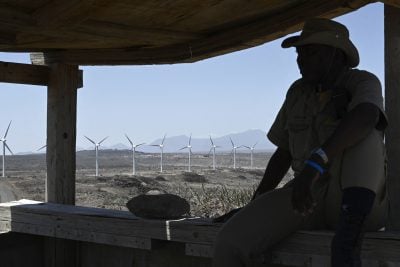Any conversation on the need to electrify the African continent – and bring power to 600 million people who lack access today – almost always revolves around solar, wind, hydro, geothermal or other forms of generating electricity.
Considerable progress is being made in installing renewable generation capacity in Africa, especially from solar sources. But for an energy system that relies on inherently intermittent sources like wind and solar to be able to function reliably, it needs some way to store electricity. This will allow power to be available when the sun isn’t shining or the wind isn’t blowing.
One of the main solutions comes in the form of battery electricity storage systems, or BESS. These function much like any other battery – they store surplus power when electricity is being generated. Then, when the system is in deficit, users can draw from the electricity stored in the battery system.
Batteries are far from the only way to store electricity. In fact, pumped hydropower – which releases water from reservoirs to generate power as needed – remains the most prevalent method of storage worldwide. BESS systems can still be vital, however, particularly given that new hydropower capacity is difficult and controversial to construct. Current BESS technologies allow for electricity to be stored for several hours; allowing, for example, energy generated by solar power during the day to be used during the evening.
In this way, battery storage is a “critical enabler” for renewable energy in Africa, says Damola Omole, director of utility innovation at the non-profit Global Energy Alliance for People and Planet (GEAPP).
A handful of large-scale battery storage systems have already been built, or are currently under construction, in Africa. A prominent example is the Kenhardt project built by Norwegian company Scatec, which began supplying electricity to South Africa’s national grid late last year. Battery storage is provided through 456 shipping container-sized units, with a total storage capacity of 225 MW – making the site one of the 10 largest battery storage systems in the world at present.
The scale of Kenhardt makes it an exception, however. Although multiple countries, including Senegal and Mozambique, are installing utility-scale BESS projects, the continent is generally lagging behind in the race to build storage capacity.
Omole warns that investment in battery storage is nowhere near sufficient for the existing pipeline of solar projects in Africa, let alone the much greater volumes of solar power likely to be deployed in the coming years. “It’s clear that the BESS investment is far from where we need it to be,” he says, adding that a “deliberate, concerted effort” is needed to ensure renewables investment in Africa encompasses the entire value chain.
Costs and risks
The biggest reason why investment in battery storage remains inadequate in Africa is very simple, says Holger Rothenbusch, managing director and head of infrastructure and climate at British International Investment, the UK’s development finance institution, which provided debt funding for the Kenhardt project. “Battery storage is lagging behind energy generation investment – and that’s mainly a reflection of the cost.”
“Projects that do include a battery component require either a fairly high tariff for the power,” he says, “or you require subsidies in order to make the project economics work and keep the tariff affordable.”
A report published earlier this year by the International Institute for Sustainable Development on BESS in South Africa found that there are still major concerns over battery costs in the country. The report’s authors, however, argued that energy system planners need to recognise the value of BESS as well as its costs. They noted that BESS brings many benefits for the entire energy system – such as reducing the need for other forms of electricity infrastructure – that are not captured by standard cost-benefit analyses.
Nevertheless, another factor making investors hesitant to support battery storage is that there are still uncertainties around the technology itself. “Technology risks are still playing out,” says Rothenbusch. “It’s not so much about building lithium-ion batteries. It’s more the question of how do they fare in the long run? What are the degradation patterns that will be coming through? No-one really knows how large-scale batteries will degrade over the next 10-15 years.”
The more positive news is that battery storage costs are gradually coming down. The International Energy Agency noted in a recent report that the costs of lithium-ion batteries (variants of which are used in almost all battery storage systems) have fallen by 90% since 2010 – “one of the fastest cost declines of any energy technology ever”. It expects costs to fall by another 40% on average by 2030.
“It’s definitely the technology of the future, and with more investment and greater capacity being built, the cost curve is also sloping down,” says Rothenbusch. “I would expect that by 2030 battery costs are going to be competitive, compared to thermal alternatives.”
Ramping-up investment
Installing battery storage is not only useful for national electricity grids. Martijn Proos, co-head of South Africa & Africa credit at Ninety One, the fund manager of the Emerging Africa Infrastructure Fund, part of the donor-funded Private Infrastructure Development Group, notes that BESS is a “key component” of mini-grids or micro-grids.
These work in basically the same way as a conventional grid, but on a smaller scale, and are often seen as a good way to bring power to remote areas where transmission and distribution infrastructure is lacking. Mini-grids may have a connection to the national grid, or can operate independently.
More broadly, Proos says that a “multifaceted approach”, involving “innovative financing mechanisms”, is needed to help Africa secure additional investment in BESS.
“Policymakers with clear, consistent, and supportive regulatory frameworks for energy storage enable investment,” says Proos. He adds that “tax breaks, subsidies, and streamlined permitting processes”, alongside efforts to modernise grids with storage components, are vital to boosting investor confidence.
Omole notes that Africa can take lessons from the likes of India and a number of southeast Asian countries that are on a “similar trajectory” and have already made considerable progress in installing battery storage.
At COP28 last year, several African countries joined the BESS Consortium, an initiative led by the GEAPP-convened Global Leadership Council that also includes various international financial institutions and UAE-based energy giant Masdar. The ultimate aim of the consortium is to help member countries prepare projects and improve the regulatory environment in order to facilitate investment.
The fact that multiple African countries signed up to the initiative shows that there is “political will” to accelerate BESS deployment, Omole says.
Indeed, he highlights that BESS is a vital part of making renewable energy successful in Africa, which in turn is crucial for closing the energy access gap. “The problem is not going away,” he warns, noting that up to 300m people in Africa have unreliable access, in addition to the 600m with no access at all.
And while acknowledging an “uphill task” in scaling-up BESS investment, Omole ultimately believes that, as more projects get up and running, Africa will reach a “tipping point”. As the value proposition becomes clear, he believes investors will rush to crowd-in battery storage investments and ensure that storage becomes a vital part of Africa’s renewable revolution.
Want to continue reading? Subscribe today.
You've read all your free articles for this month! Subscribe now to enjoy full access to our content.
Digital Monthly
£8.00 / month
Receive full unlimited access to our articles, opinions, podcasts and more.
Digital Yearly
£70.00 / year
Our best value offer - save £26 and gain access to all of our digital content for an entire year!

 Sign in with Google
Sign in with Google 



